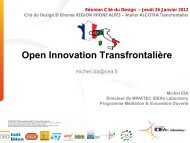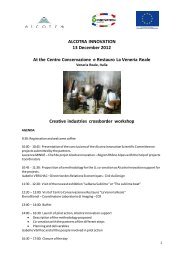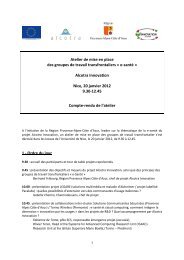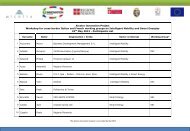Best practices Database for Living Labs - ALCOTRA - Innovation
Best practices Database for Living Labs - ALCOTRA - Innovation
Best practices Database for Living Labs - ALCOTRA - Innovation
Create successful ePaper yourself
Turn your PDF publications into a flip-book with our unique Google optimized e-Paper software.
Figure 11: The <strong>Living</strong> Lab <strong>Innovation</strong> ‘Vortex’ (from: [3])<br />
User engagement can be differentiated in terms of intensity, between<br />
• Reactive modes, <strong>for</strong> example giving feedback on an existing proposal, prototype or product, and<br />
• Proactive modes, <strong>for</strong> example becoming a source of innovation or ideas to improving a product or<br />
service along its development process.<br />
In theory, the benefits of user involvement in the development of new products, services and processes are<br />
quite relevant: expected added values are <strong>for</strong> example higher acceptance among stakeholders, better hitrates<br />
and faster time-to market. Involving users in the development of interactive systems and innovative<br />
solutions typically increases the likelihood that those new products and/or services will be useful and<br />
usable: empirical evidence suggests that user involvement is beneficial in such developments [31].<br />
Let us take an example from IT industry: nowadays, IT investments are considered failures if they do not<br />
produce an added value <strong>for</strong> the users. Actually, in order to increase the probability that users will use a<br />
public IT system when it is introduced in the competitive and open market, this must offer users an added<br />
value of some sort. There<strong>for</strong>e, it is important to gain knowledge about what the intended users need and<br />
want from technology. One obvious way to gain knowledge about users and their needs is to engage them<br />
on the development and testing process run by the IT firms themselves.<br />
In market research, experts usually investigate end user needs. User engagement goes one step further. It<br />
is not purely about assessing and considering user needs in the product/service development process, but<br />
also about actively involving end users. There<strong>for</strong>e, suggestions, remarks and recommendations from them<br />
need to be taken seriously: this represents an innovative business model, which asks product developers<br />
and researchers to accept the user as benchmark <strong>for</strong> the design of a new product or service.<br />
The strategy of this new business model, strongly linked to people, is to cooperate in a productive and<br />
effective manner in order to jointly develop appropriate products in a bottom-up fashion: according to this<br />
perspective, social innovation is recognized as a crucial source of innovativeness in <strong>Living</strong> <strong>Labs</strong>.<br />
3.5.5 <strong>Innovation</strong> outcomes<br />
The single most consensual feature of <strong>Living</strong> <strong>Labs</strong> is their overarching purpose, as captured in part (5) of the<br />
ENoLL’s definition. <strong>Living</strong> <strong>Labs</strong> are strongly expected to be plat<strong>for</strong>ms fostering business innovation in a way<br />
that bridges the crucial gap between market pull, commercially oriented product/service development and<br />
research push, technology driven solution proposal and product/service prototyping (see next picture).<br />
The project is co-funded by the ERDF<br />
Page 23 of 78









